Did you know that over 30% of motorcycle breakdowns occur in the fall due to missed seasonal maintenance? That means a third of riders are forced off the open road just as the leaves start to change — all because they skipped crucial upkeep. Don’t let a simple oversight cut your fall motorcycle rides short. With the right fall motorcycle maintenance tips, you’ll ride every autumn mile with confidence, enjoying crisp weather, vibrant foliage, and a trusted bike beneath you. Let’s dive into the essential steps to keep your motorcycle running smoothly and avoid being part of that statistic.
Why Fall Motorcycle Maintenance Tips Are Critical for Every Rider
- Did you know that over 30% of motorcycle breakdowns occur in the fall due to missed seasonal maintenance? Discover why smart riders prioritize fall motorcycle maintenance tips for safer, longer rides.
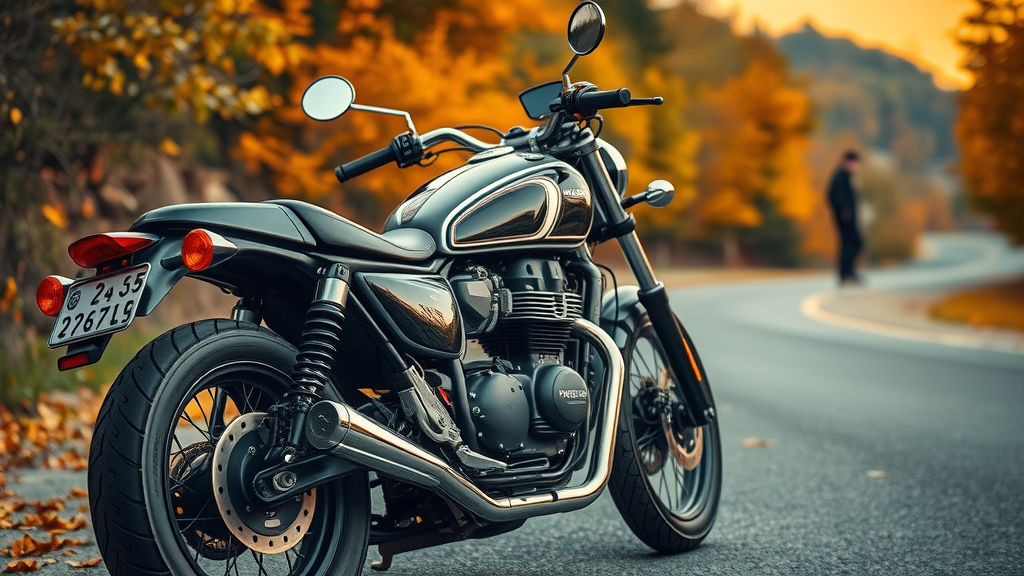
As the riding season transitions from the sweltering heat of summer into cool, crisp fall riding, your motorcycle faces a unique set of challenges. Leaf-strewn roads, fluctuating temperatures, and increased moisture all demand extra vigilance and expert fall motorcycle maintenance tips. Whether you're planning long motorcycle rides through the countryside or simply commuting, regular maintenance during this time is crucial to ensure your bike is in top shape and ready for whatever autumn brings.
Unlike spring or summer, fall brings cooler temperatures that affect your engine oil viscosity, tire pressure, and battery life. Moisture from morning dew and falling leaves can impact your traction and mechanical components, so it’s a good idea to adjust your maintenance checklist accordingly. Riders who follow an autumn-specific maintenance plan not only reduce the risk of unexpected breakdowns but also extend the life of their bikes, ensuring every ride is safe and enjoyable. Proactive care isn’t just about avoiding problems—it’s about maximizing your enjoyment on the open road.
Essential Fall Motorcycle Maintenance Tips for Every Motorcycle Ride
"A well-maintained motorcycle in fall not only prolongs ride time but ensures you’re prepared for sudden temperature drops and road hazards." – Certified Motorcycle Mechanic
- Inspection checklist for fall rides
- Common mistakes to avoid
- Practical steps for DIY care
| Maintenance Task | Recommended Frequency | Key Benefits |
|---|---|---|
| Fuel Stabilizer Usage | Every fill-up | Prevents fuel degradation |
| Check Tire Pressure | Weekly | Improves grip and safety |
| Fluid Levels Inspection | Bi-weekly | Protects engine and brakes |
| Battery Check | Monthly | Prevents cold start issues |
| Chain Lubrication | Every 500 miles | Reduces wear and tear |
Every maintenance task on this checklist is designed to keep your bike running smoothly despite the shifting weather. Incorporating these fall motorcycle maintenance tips into your routine helps protect components vulnerable to damage during the cooler months. For example, using a fuel stabilizer every fill-up shields your fuel system from degradation — especially important if you end up riding less as winter approaches. Weekly tire pressure checks maximize grip on colder, slicker roads, while regular inspections of fluid levels and the battery ensure reliability whenever you need to hit the open road.
Motorcycle Maintenance Checklist: Stay Ready for Fall Motorcycle Rides
Inspecting Your Tires: Check Your Tire and Tread for Top Shape
- How to check your tire pressure for fall rides
- Signs your tire tread needs attention
- Tips for optimal tire maintenance
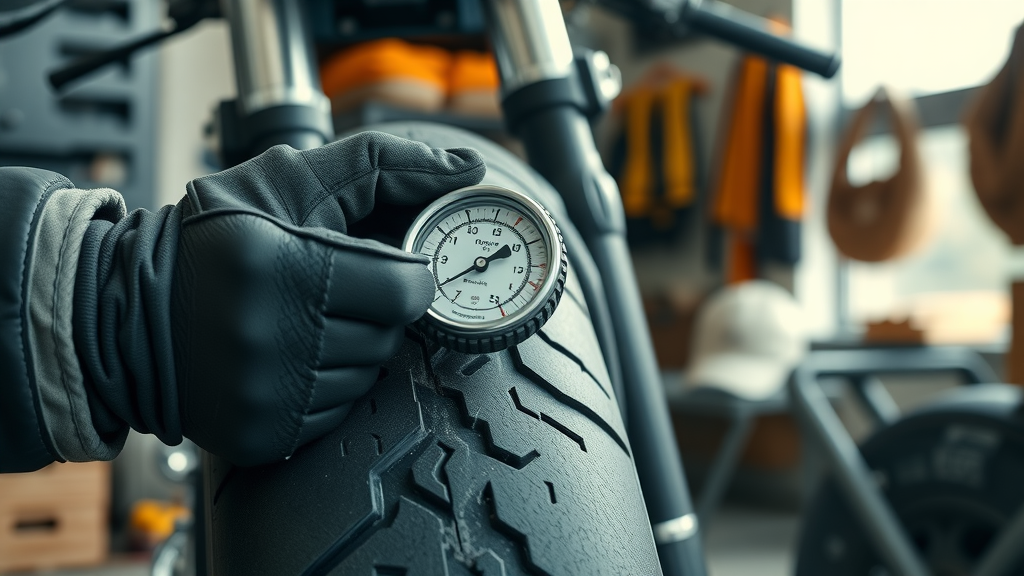
Checking your tire pressure is a core part of any fall motorcycle maintenance checklist. Cooler air causes tire pressure to drop, which can compromise your motorcycle’s handling and grip, particularly on damp, leaf-covered roads. Before every fall motorcycle ride, make it a habit to use a reliable tire gauge and ensure both front and rear tires are inflated to the manufacturer's recommended levels. Signs that your tires need attention include uneven wear patterns, cracks in the sidewall, or visible flattening in any part of the tread. Running on improperly inflated or worn tires not only shortens their lifespan but also increases your risk on every ride.
Beyond tire pressure, take extra time to inspect your tread depth. Motorcycle rides during fall often encounter wet or slick pavement, so ensuring your tread is deep enough to channel away water and debris is critical. Press a penny into the groove of your tire’s tread—if you can see the top of Lincoln’s head, it’s a good idea to replace the tire. Finally, clean off any built-up mud, salt, or leaves from the tires after each ride to reduce the risk of slipping and increase the longevity of your investment. Regular inspections mean your motorcycle stays in top shape, ready for every turn and bump along the scenic autumn route.
Checking and Changing Fluid Levels for Optimal Motorcycle Maintenance
- Coolant, oil, and brake fluid: what to look for
- Why fluid levels are crucial in cooler weather
- When to schedule a change
Monitoring fluid levels becomes even more important during fall motorcycle rides. Between coolant, engine oil, and brake fluid, each plays a vital role in keeping your bike running smoothly in cooler temperatures. As the weather cools, oil can thicken, reducing its ability to lubricate engine parts efficiently. Always check your oil and filter before a major fall ride, ensuring the oil is clean and at the optimal viscosity for cold weather operation. If in doubt, changing your engine oil as the season shifts is a small cost for added peace of mind.
Don’t overlook your coolant and brake fluid, as these are also crucial to ensure your bike remains in good condition. Low coolant levels can cause your engine to overheat even when temperatures are cool outside, and degraded brake fluid can significantly affect performance on slippery autumn roads. A great time to change fluids is at the start of the season, or if you haven’t performed this maintenance in the past six months. Make sure both fluids are at appropriate levels and free from contamination or discoloration prior to storage or long rides—your safety depends on it.
Using a Fuel Stabilizer as Part of Your Fall Motorcycle Maintenance Checklist
- What is a fuel stabilizer and why use it in fall
- Step-by-step guide to application
- Protecting your fuel system against winter
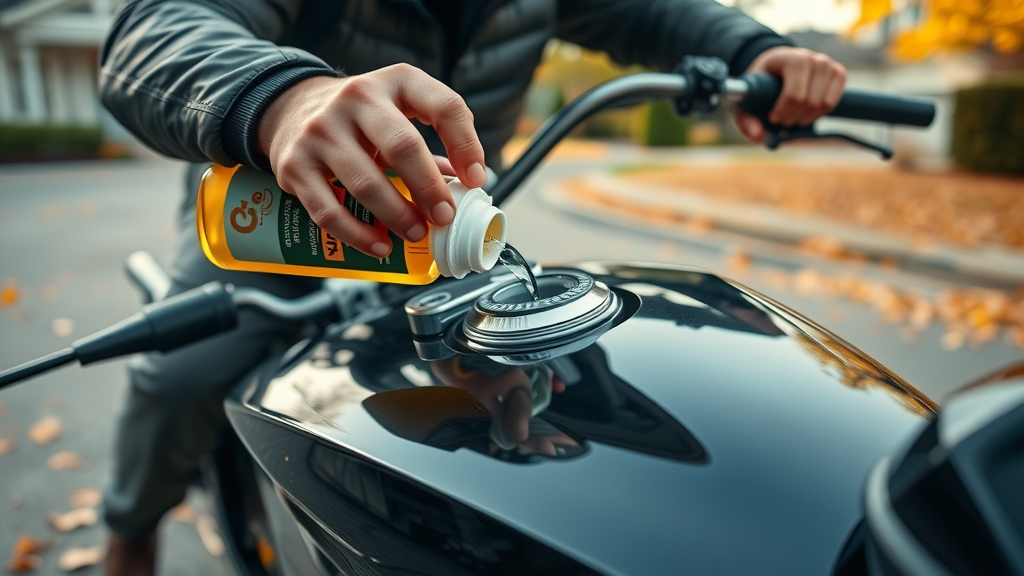
A fuel stabilizer is an essential preventive step often overlooked during fall motorcycle maintenance. As riding frequency drops with cooler temperatures, gasoline can start to break down and form varnish or gum, leading to clogged injectors and a difficult start when spring returns. Adding a fuel stabilizer during every fill-up—or particularly before long storage periods—keeps your gas in prime condition and ensures your motorcycle starts without frustration, even after weeks of inactivity.
Application is straightforward: pour the recommended amount of fuel stabilizer into your tank before topping off with fresh fuel, then run the engine for a few minutes to distribute the product throughout the fuel system. This simple habit protects against fuel degradation, moisture buildup, and corrosion inside your tank and lines. Especially if you expect to ride less as the days get shorter or are preparing for winter storage, don’t skip this step. Your future self will thank you when your motorcycle fires up without a hitch come spring.
Preparing Your Fall Motorcycle for the Best Motorcycle Rides Ahead
Battery Care: Keep Your Fall Motorcycle in Top Shape
- Signs your battery needs attention
- How temperature shifts impact battery health
- Maintenance tips for longer battery life
Colder fall nights can sap the strength from even the best motorcycle batteries, making battery maintenance a priority as riding season winds down. Signs that your battery needs attention include sluggish engine starts, dim headlights, and corrosion on battery terminals. If your battery is more than two years old, have it checked with a voltmeter—proactively replacing a weak battery can save you from a roadside stall in chilly weather.
Temperature drops slow the chemical reactions inside your battery, diminishing its ability to hold a full charge. To maintain top shape, consider using a trickle charger or battery tender when your bike isn’t ridden for more than a week. Regularly inspect connections for tightness and clean off any corrosion to ensure reliable starts. If storing your motorcycle during winter months, always disconnect the battery and keep it on a maintained charge to prolong its lifespan and reduce the risk of sudden breakdowns come spring.
Brake System Inspection for Safe Fall Motorcycle Maintenance
- Checking pads and rotors
- Replacing brake fluid
- Addressing squeaks and performance concerns
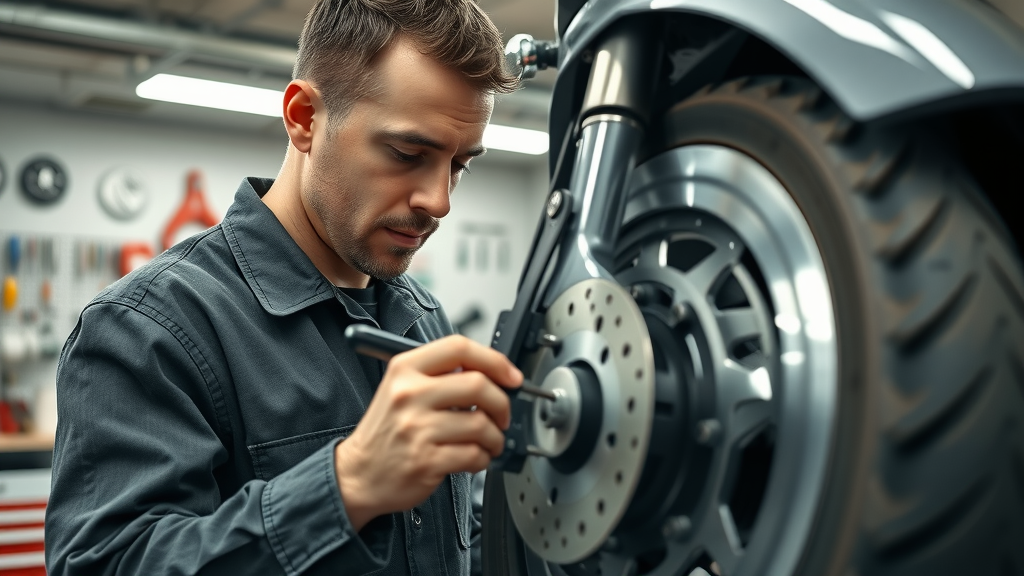
Reliable brakes are crucial to ensure your motorcycle ride remains safe—especially when wet leaves and slick pavement increase stopping distances. Start your brake inspection by checking pad thickness: if the pads are thinner than the width of a nickel, replace them. Next, examine the brake rotors for grooves, warping, or discoloration, which indicate it might be time for resurfacing or replacement.
Equally important is your brake fluid. Fall’s cooler temperatures can cause moisture to condense within your brake system, reducing effectiveness. Top off or replace brake fluid if it appears cloudy or dark, and always use the manufacturer’s specified fluid type. Listening for squeaks, grinding sounds, or mushy lever feel are also important cues for further inspection. By incorporating these checks into your maintenance checklist, you’ll reduce the risk of brake failures and ensure excellent stopping power for all your autumn rides.
Chain Lubrication and Cleaning: Key Fall Motorcycle Maintenance Tips
- How to clean and lubricate properly
- Tools and products for best results
- Frequency recommendations
A clean and well-lubricated chain is vital to keeping your bike running smoothly and safely during fall rides. Begin each maintenance session by using a motorcycle-specific chain cleaner and a soft brush to remove dirt, debris, and old lubricant—a process best done after a short ride, while the chain is still warm. Once the chain is clean and dry, apply high-quality chain lube, evenly covering every link. Wipe away excess to prevent dirt buildup but ensure enough remains to protect against rust and wear.
Chain maintenance frequency should increase as days become wetter and grittier—plan to clean and lubricate every 500 miles or after riding through heavy rain or dirty roads. Use the time to inspect the chain for slack or kinks, tightening if necessary according to your owner’s manual. This not only ensures a smoother, quieter ride but also extends the lifespan of your drivetrain, minimizing surprises during the best motorcycle rides of the season.
Advanced Fall Motorcycle Maintenance: Going Beyond the Basics
Inspecting Suspension and Lighting for Safe Motorcycle Rides
- Why suspension matters in fall and how to adjust it
- Ensuring your lighting is bright and responsive

Your motorcycle’s suspension plays a pivotal role in maintaining control and comfort on uneven fall roads. As the temperature drops, rubber components can stiffen, and moving parts may require extra lubrication. Take the extra time to check for leaks, unusual noises, or play in the fork and rear shock, and adjust preload or damping settings based on your fall riding load and preferences. Well-maintained suspension can mean the difference between a comfortable journey and a jarring, unpredictable ride.
Lighting is another area not to overlook, as shorter days and frequent overcast weather can challenge visibility for both you and other road users. Test all bulbs — headlight, taillight, brake, and turn signals — to confirm they shine brightly and respond instantly. Switch to LEDs for increased durability and brightness if needed, and always clean lenses regularly to cut through the autumn mist. These checks are both a good idea and a crucial safety measure during the fall riding season.
Seasonal Storage and Protection Tips for Your Fall Motorcycle
- Choosing the right cover and storage space
- Protecting against moisture and rodents
- Checklist for winterization
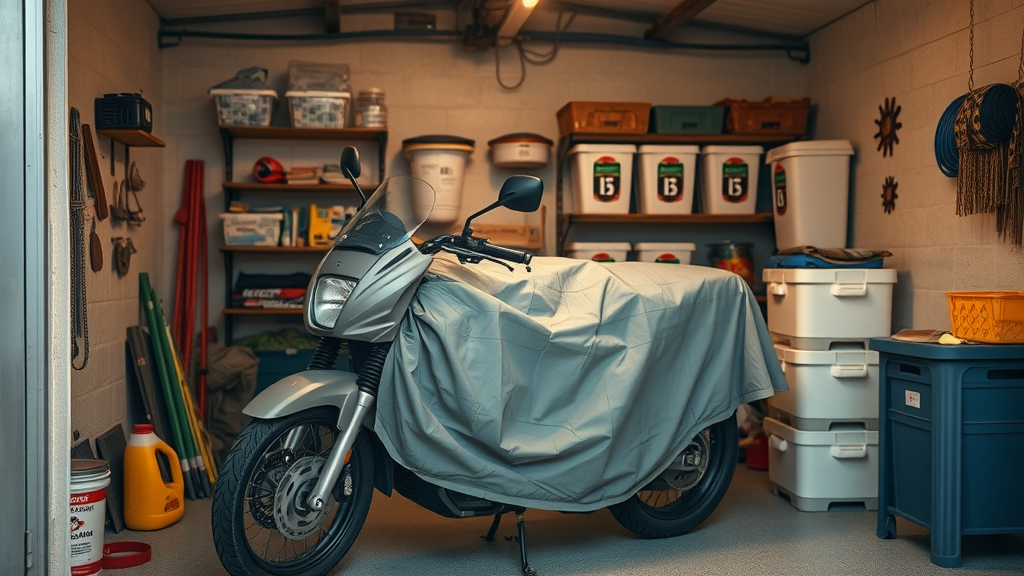
Even if you ride through much of fall, there often comes a point when storing your motorcycle for the winter months makes sense. Begin by selecting a dry, well-ventilated garage or storage space, ideally protected from drastic temperature shifts. Use a high-quality cover designed to breathe, preventing condensation and moisture buildup without trapping humidity around your bike. Prior to storage, clean your motorcycle thoroughly, apply a fuel stabilizer, and inflate the tires to protect from flat spots.
Protect against rodents by sealing entry points and placing deterrents near your motorcycle, while moisture absorbers keep the air dry and hardware rust-free. Remove or trickle charge the battery, lubricate all movable parts, and cover intake/exhaust openings with breathable material to keep insects and debris out. Use this winterization checklist to ensure your bike emerges from storage in good condition , ready to hit the ground running when spring arrives.
What Riders Also Ask About Fall Motorcycle Maintenance Tips
What to do when you fall off your motorcycle?
- Stay calm, check for injuries, move out of harm’s way if safe. Assess your motorcycle for damage before riding again. Always carry a basic first aid and tool kit.
What is the most important maintenance on a motorcycle?
- While all maintenance is critical, your maintenance checklist should start with fluid levels, brake checks, and tire pressure for safety and reliability.
Can you ride a motorcycle in October?
- Yes, with proper fall motorcycle maintenance tips followed, riding in October is safe and enjoyable. Ensure your bike, gear, and riding plans are all season-ready.
How to pick up a motorcycle when it falls?
- Turn off the engine, stand with your back to the seat, grip the handlebars and rear frame, and use your legs to lift gradually. Practice in a safe area first.
Expert Recommendations and Fall Motorcycle Maintenance Tips Recap
- Summary of key fall motorcycle maintenance tips
- Tips from professional motorcycle mechanics
- Checklist for your next motorcycle ride
Following these fall motorcycle maintenance tips means you can embark on every fall motorcycle ride with confidence and peace of mind. Expert mechanics agree: staying proactive with your maintenance checklist, from oil and filter changes to keeping your chain lubricated and your battery charged, makes all the difference. Prepare for cooler temperatures, unpredictable weather, and storage with the right steps — and you’ll be rewarded with seamless, enjoyable rides all season long.
Common Fall Motorcycle Maintenance FAQs
- How often should I check my tire pressure during fall? Weekly, or more often during temperature swings.
- Is it necessary to use a fuel stabilizer if I ride weekly? While less critical for daily riders, it’s a good idea as insurance against unexpected cold spells or inactivity.
- What’s the best way to prep my motorcycle for off-season storage? Clean thoroughly, stabilize fuel, inflate tires, trickle charge the battery, and protect against moisture and rodents.
Stay Road-Ready: Connect with Fall Motorcycle Maintenance Experts
- Ensure your next motorcycle ride is smooth and safe. For personalized fall motorcycle maintenance tips, maintenance checklists, and expert service, call Nasty Performance Motorcycle Shop today: 847-458-4858.
Take action now: Review your fall motorcycle maintenance checklist and schedule a service with pros for maximum fall riding confidence!
To enhance your understanding of fall motorcycle maintenance, consider exploring these authoritative resources:
This comprehensive guide offers a detailed fall maintenance checklist, emphasizing the importance of brake inspections, fluid checks, and gear assessments to ensure safe and efficient riding during the autumn months.
This resource provides a thorough maintenance checklist tailored for both spring and fall, highlighting essential tasks such as battery care, fluid maintenance, and tire inspections to keep your motorcycle in optimal condition throughout the changing seasons.
By consulting these resources, you’ll gain valuable insights and practical tips to keep your motorcycle performing at its best during the fall season.
 Add Row
Add Row  Add
Add 



Write A Comment